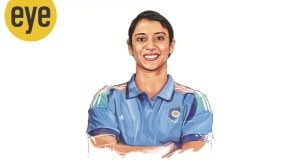Baramati Burgundy
Four hours away, some 10 kms from Nashik, in Maharashtra, a dirt track goes to the edge of the first earthen dam in Asia, Gangapur. Owned by...

Four hours away, some 10 kms from Nashik, in Maharashtra, a dirt track goes to the edge of the first earthen dam in Asia, Gangapur. Owned by Rajeev Samant, Sula vineries is not expecting visitors and there are no signs to guide you to the vinery. Ask the village boys on the way and they happily point to the ‘daroo’ (hooch) factory. Two, low, widely-spaced Mangalore-tiled units sit in the middle of the 15-acre vineyard. A hill covered with wild trees is to the rear and the sloping grounds offer a sweeping view of the dam in the front.
The openness of the vineyard, the type of soil, everything goes into the taste of the grape. Different kinds of grapes brought together form a blend. Twenty staffers from Olive, a Mediterranean restaurant in suburban Mumbai, have also made the trip. There is talk of yet another blend for the restaurant. Explains Ajoy Shaw, Sula’s winemaker, helpfully, ‘‘Blending is the art, rest is all science,’’ leading the way to the drum where the grape is crushed.
|
The bottling plant at Chateau Indage for its sparkling wine
|
The young biotechnologist with a French beard deconstructs the romance and secrets of wine. It is like watching a magician making a dove vanish with a click of his fingers — Ph value, acidity, yeast, carbon dioxide. The cool shed has a tarpaulin ceiling, gangways, drains and a bottling plant in the centre.
Eight 15,000 litre drums, four in each row, gleam under the sodium lamps. The cellar is packed with dark green bottles from the ceiling to the floor. Different caps mark different batches. ‘‘Do not touch the bottles, they can explode,’’ Shaw issues a strict instruction. Sula’s production is 65,000 litres this year. A small halt at the lab of test tubes and pipettes and it is time for the best part of the trip — the winetasting.
Wine production and consumption has reached new highs where the tinkling glass of wine has knocked off the Patiala peg from the bar menu. Bloody Marys, Manhattans and Vodka shots are skipped over and eyes linger over wine lists at restaurants and bars. In the social calendar of Mumbai and New Delhi, a wine-tasting session has become as common as a film festival. Yet, wine has a snob value which promoters believe should be dropped at once.
Ask Chef Dev Malik of Olive, a firm believer of making wine more friendly. ‘‘Right now, the wine business is minuscule but it is growing at an enormous pace. Five times over in five years. We have to make wine approachable. Attainable. You have to attack the prices if you want to make it grow.’’
|
Revellers at a harvest celebration in Narayangaon
|
Prices are wound around strangulating taxes but there is hope in the recent new convert, Vishwas Dhumal, Secretary (Industries), whose wine-friendly excise policy could remove the roadblocks to cheaper wine. Sitting in his office in Mantralaya, the seat of power of the Maharashtra government, Dhumal says one of the priority areas in the state’s horticulture policy is wine, ‘‘It’s amazing how tightly we had bound this industry; it just didn’t have any chance to grow.’’
The government has listed the problem areas — licences, excise duty and sales tax. Fifty new licences for vineries have been issued in the state and excise duty has been slashed by 75 per cent. Old vineries in the state — Sula, Chateau Indage and Baramati Grape Industries — will benefit with a 50 per cent tax cut. With these hurdles out of the way, the government has big plans.
A wine park in Sangli and Nashik; a wine institute at Nashik; incentives to farmers to switch from growing table to wine grapes; more outlets for wines as opposed to liquor shops; special licences for selling just wine; wine bars like beer bars. The Karnataka government, another wine-producing state, has decided to take a shortcut. It has simply copied and pasted Maharashtra’s wine policy.
An array of reds, whites and pinks sit on the table in the verandah waiting to be tasted. There are chairs, an armchair and a jhoola. Grab the jhoola. With every sip, you want to be in a more horizontal position. It is hot, and Rocky, the vineyard dog, flops on the floor and watches Shaw begin.
‘‘Wine is a very personal experience,’’ he says and then proceeds to advise us on how to swirl, inhale and then sip the wine. The emphasis is on the drinker’s level of comfort and to break the stuffiness around wine. Sula needs a good four to five hours for a proper tour and the recovery thereafter. One could laze in the living room which has a pool table and several inviting loungers.
Shaw, who has done a stint in California near Napa Valley, and the vinery manager, Pradip Pachpatil, believe that for Rs 50 per head for the tasting, they could draw in good crowds. The best season to visit are during the rains (June to September) and after. The hot weather has not fazed a local official and his childhood friends—a marine biologist and a marketing consultant—who have made the trip from Nashik. The men discuss varieties of the grapes, wines and compare it to their overseas experience. Launched in 1999, Sula has done well; it has tied up with hotels like the Taj President, the Leela and Regent chain and restaurants like Olive and Indigo in Mumbai.
Further down in Pune, a couple of kilometres from Narayangaon, Chateau Indage sits proudly against the ghats. Compared to Sula, Chateau Indage is an old lady, set up 18 years ago. The road to the vinery is lined by beds of periwinkle. The scale of the vineyards and the vinery are several times over. Laurent Dubreil, the resident winemaker from France for six months, gushes about the weather. ‘‘Very good weather. Very good grapes. Cannot make bad wines.’’
The vinery buys a lot of grape from the local farmers. He walks around the nearly two-metre-high vines and frowns at the changing techniques over the years. The lawns in front of his house has a pool, where ‘‘we dumped a ton of grapes and crushed it with our feet,’’ and a bar. He recalls how almost 3,000 people from across the country came over in February for their annual wine festival. Wine critics descended from Europe and it was quite a party.
When Dubreil takes you tasting he goes straight to the big tanks in which the fermentation is still on. He opens the tap, rinses the glass with the wine, opens the tap again, brings the glass to his nose, a sniff, a sip and spits it in the drain. We just copy him. He darts from one big tank to the other, offering you quite a range. Friday and Saturday are cleaning day, it is wet all over; avoid these days for a visit. The next stop is the cellar for the sparkling wine. In between mountains of bottles, are some oak barrels. The barrels lie on their stomach with a silicon cork around which sulphur powder has been sprinkled to keep away the fruitflies.
With a pipette, he draws out some wine. Dubreil’s demeanour has changed, you can make out this is quality stuff. No more rinsing with wine; the undrunk portion goes right back into the barrel. Outside, Mohan Shirsegar who has been working at Indage for a long time, spikes his Marathi with perfectly pronounced French wine names.
The oldest vinery in the state is in Baramati. Local farmers, Sharad Pawar and McDowell’s—all have their finger in the pie and the vinery crushes upwards of 6,000 tonnes of grape every year. D D Tupe, the winemaker, learnt from Dr Rossi of the Italian Chamber of Commerce in the Seventies. They have a tie-up with the Italian label, Bosca. Those of weak stomach had better skip the journey south-east of Pune. The tanks are made of cement and the vinery reeks with a vengeance. Men sit in the dying afternoon light and scrub at a mountain of used bottles. The plant has taken to manufacturing spirit.
Tupe says they have plans to make sparkling wine next year. In the lab, however, the winemaker allows you a tasting session. ‘‘The idea is to maintain the naturalness of the grapes,’’ smiles Tupe. Twenty minutes is all you can risk in Baramati Grape Industries. But it is worth driving around the vinery. Vineyards are spread over limitless acres.
Forget the Napa Valley, winemaking in this region effortlessly blends into the rural scene.



- 01
- 02
- 03
- 04
- 05




























